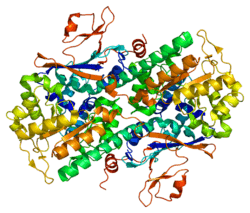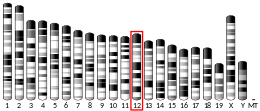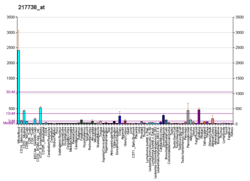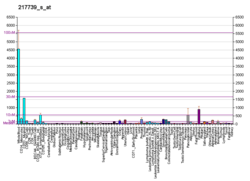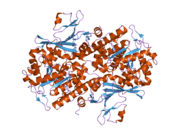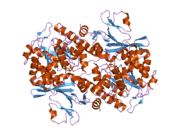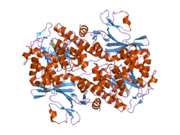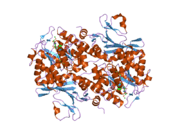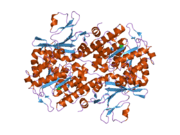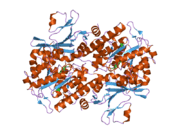Nicotinamide phosphoribosyltransferase
Nicotinamide phosphoribosyltransferase (NAmPRTase or Nampt) also known as pre-B-cell colony-enhancing factor 1 (PBEF1) or visfatin is an enzyme that in humans is encoded by the NAMPT gene.[5] This protein is the rate-limiting enzyme in the Nicotinamide adenine dinucleotide (NAD+) salvage pathway that converts nicotinamide to nicotinamide mononucleotide in mammals to enable NAD+ biosynthesis.[6] NAMPT has also been reported to be a cytokine (PBEF) that promotes B cell maturation and inhibits neutrophil apoptosis.
| nicotinamide phosphoribosyltransferase | |||||||||
|---|---|---|---|---|---|---|---|---|---|
| Identifiers | |||||||||
| EC number | 2.4.2.12 | ||||||||
| CAS number | 9030-27-7 | ||||||||
| Databases | |||||||||
| IntEnz | IntEnz view | ||||||||
| BRENDA | BRENDA entry | ||||||||
| ExPASy | NiceZyme view | ||||||||
| KEGG | KEGG entry | ||||||||
| MetaCyc | metabolic pathway | ||||||||
| PRIAM | profile | ||||||||
| PDB structures | RCSB PDB PDBe PDBsum | ||||||||
| Gene Ontology | AmiGO / QuickGO | ||||||||
| |||||||||
Expression and regulation
NAMPT is downregulated by an increase of miR-34a in obesity via a 3'UTR functional binding site of NAMPT mRNA resulting in a reduction of NAD(+) and decreased SIRT1 activity.[7]
Reaction
NAMPT catalyzes the following chemical reaction:
- nicotinamide + 5-phosphoribosyl-1-pyrophosphate (PRPP) nicotinamide mononucleotide (NMN) + pyrophosphate (PPi)
Thus, the two substrates of this enzyme are nicotinamide and 5-phosphoribosyl-1-pyrophosphate (PRRP), whereas its two products are nicotinamide mononucleotide and pyrophosphate.[6]
This enzyme belongs to the family of glycosyltransferases, to be specific, the pentosyltransferases. This enzyme participates in nicotinate and nicotinamide metabolism.
Function
NAmPRTase catalyzes the condensation of nicotinamide with 5-phosphoribosyl-1-pyrophosphate to yield nicotinamide mononucleotide, one step in the biosynthesis of nicotinamide adenine dinucleotide. The protein is an adipokine that is localized to the bloodstream and has various functions, including the promotion of vascular smooth muscle cell maturation and inhibition of neutrophil apoptosis. It also activates insulin receptor and has insulin-mimetic effects, lowering blood glucose and improving insulin sensitivity. However, the paper was retracted in 2007. The protein is highly expressed in visceral fat and serum levels of the protein correlate with obesity. This gene has a pseudogene on chromosome 10.[8][9]
Recently, it has been demonstrated that NAMPT could bind to and activate TLR4.[10]
Nomenclature
The systematic name of this enzyme class is nicotinamide-nucleotide:diphosphate phospho-alpha-D-ribosyltransferase. Other names in common use include:
- NMN pyrophosphorylase,
- nicotinamide mononucleotide pyrophosphorylase,
- nicotinamide mononucleotide synthetase, and
- NMN synthetase.
History
Nampt/PBEF/visfatin was originally cloned as a putative cytokine shown to enhance the maturation of B cell precursors in the presence of Interleukin-7 (IL-7) and stem cell factor, it was therefore named "pre-B cell colony-enhancing factor" (PBEF).[5] When the gene encoding the bacterial nicotinamide phosphoribosyltransferase (nadV) was first isolated in Haemophilus ducreyi, it was found to exhibit significant homology to the mammalian PBEF gene.[11] Rongvaux et al.[12] demonstrated genetically that the mouse PBEF gene conferred Nampt enzymatic activity and NAD-independent growth to bacteria lacking nadV. Revollo et al.[13] determined biochemically that the mouse PBEF gene product encodes a Nampt enzyme, capable of modulating intracellular NAD levels. Others have since confirmed these findings.[14] More recently, several groups have reported the crystal structure of Nampt/PBEF/visfatin and they all show that this protein is a dimeric type II phosphoribosyltransferase enzyme involved in NAD biosynthesis.[15][16][17]
Hormone claim retracted
Although the original cytokine function of PBEF has not been confirmed to date, others have since reported or suggested a cytokine-like function for this protein.[18] In particular, Nampt/PBEF was recently re-identified as a "new visceral fat-derived hormone" named visfatin.[19] It is reported that visfatin is enriched in the visceral fat of both humans and mice and that its plasma levels increase during the development of obesity.[19] Noteworthy is that visfatin is reported to exert insulin-mimetic effects in cultured cells and to lower plasma glucose levels in mice by binding to and activating the insulin receptor.[19] However, the physiological relevance of visfatin is still in question because its plasma concentration is 40 to 100-fold lower than that of insulin despite having similar receptor-binding affinity.[19][20][21] In addition, the ability of visfatin to bind and activate the insulin-receptor has yet to be confirmed by other groups.
On 26 October 2007, A. Fukuhara (first author), I.Shimomura (senior author) and the other co-authors of the paper,[19] who first described Visfatin as a visceral-fat derived hormone that acts by binding and activating the insulin receptor, retracted the entire paper[19] at the suggestion of the editor of the journal 'Science' and recommendation of the Faculty Council of Osaka University Medical School after a report of the Committee for Research Integrity.[22]
As a drug target
APO866 is an experimental drug that inhibits this enzyme.[23] It is being tested for treatment of advanced melanoma, cutaneous T-cell lymphoma (CTL), and refractory or relapsed B-chronic lymphocytic leukemia.
Anti-aging biomedical company Calico has licensed the experimental P7C3 analogs involved in enhancing NAMPT activity.[24] P7C3 compounds have been shown in a number of publications to be beneficial in animal models for age-related neurodegeneration.[25][26]
References
- GRCh38: Ensembl release 89: ENSG00000105835 - Ensembl, May 2017
- GRCm38: Ensembl release 89: ENSMUSG00000020572 - Ensembl, May 2017
- "Human PubMed Reference:". National Center for Biotechnology Information, U.S. National Library of Medicine.
- "Mouse PubMed Reference:". National Center for Biotechnology Information, U.S. National Library of Medicine.
- Samal B, Sun Y, Stearns G, Xie C, Suggs S, McNiece I (February 1994). "Cloning and characterization of the cDNA encoding a novel human pre-B-cell colony-enhancing factor". Molecular and Cellular Biology. 14 (2): 1431–7. doi:10.1128/MCB.14.2.1431. PMC 358498. PMID 8289818.
- Revollo JR, Grimm AA, Imai S (March 2007). "The regulation of nicotinamide adenine dinucleotide biosynthesis by Nampt/PBEF/visfatin in mammals". Current Opinion in Gastroenterology. 23 (2): 164–70. doi:10.1097/MOG.0b013e32801b3c8f. PMID 17268245.
- Choi SE, Fu T, Seok S, Kim DH, Yu E, Lee KW, Kang Y, Li X, Kemper B, Kemper JK (December 2013). "Elevated microRNA-34a in obesity reduces NAD+ levels and SIRT1 activity by directly targeting NAMPT". Aging Cell. 12 (6): 1062–72. doi:10.1111/acel.12135. PMC 3838500. PMID 23834033.
- "Entrez Gene: PBEF1 pre-B-cell colony enhancing factor 1".
- Fukuhara, Atsunori; Matsuda, Morihiro; Nishizawa, Masako; Segawa, Katsumori; Tanaka, Masaki; Kishimoto, Kae; Matsuki, Yasushi; Murakami, Mirei; Ichisaka, Tomoko (26 October 2007). "Retraction". Science. 318 (5850): 565. doi:10.1126/science.318.5850.565b. ISSN 1095-9203. PMID 17962537.
- Garcia, Joe G. N.; Liang, Jie; Wang, Ting; Yousef, Mohammed; Saadat, Laleh; Letsiou, Eleftheria; Sammani, Saad; Quijada, Hector; Siddiqui, Shahid S. (14 August 2015). "Unique Toll-Like Receptor 4 Activation by NAMPT/PBEF Induces NFκB Signaling and Inflammatory Lung Injury". Scientific Reports. 5: 13135. doi:10.1038/srep13135. ISSN 2045-2322. PMC 4536637. PMID 26272519.
- Martin PR, Shea RJ, Mulks MH (February 2001). "Identification of a plasmid-encoded gene from Haemophilus ducreyi which confers NAD independence". Journal of Bacteriology. 183 (4): 1168–74. doi:10.1128/JB.183.4.1168-1174.2001. PMC 94989. PMID 11157928.
- Rongvaux A, Shea RJ, Mulks MH, Gigot D, Urbain J, Leo O, Andris F (November 2002). "Pre-B-cell colony-enhancing factor, whose expression is up-regulated in activated lymphocytes, is a nicotinamide phosphoribosyltransferase, a cytosolic enzyme involved in NAD biosynthesis". European Journal of Immunology. 32 (11): 3225–34. doi:10.1002/1521-4141(200211)32:11<3225::AID-IMMU3225>3.0.CO;2-L. PMID 12555668.
- Revollo JR, Grimm AA, Imai S (December 2004). "The NAD biosynthesis pathway mediated by nicotinamide phosphoribosyltransferase regulates Sir2 activity in mammalian cells". The Journal of Biological Chemistry. 279 (49): 50754–63. doi:10.1074/jbc.M408388200. PMID 15381699.
- van der Veer E, Nong Z, O'Neil C, Urquhart B, Freeman D, Pickering JG (July 2005). "Pre-B-cell colony-enhancing factor regulates NAD+-dependent protein deacetylase activity and promotes vascular smooth muscle cell maturation". Circulation Research. 97 (1): 25–34. doi:10.1161/01.RES.0000173298.38808.27. PMID 15947248.
- Wang T, Zhang X, Bheda P, Revollo JR, Imai S, Wolberger C (July 2006). "Structure of Nampt/PBEF/visfatin, a mammalian NAD+ biosynthetic enzyme". Nature Structural & Molecular Biology. 13 (7): 661–2. doi:10.1038/nsmb1114. PMID 16783373.
- Kim MK, Lee JH, Kim H, Park SJ, Kim SH, Kang GB, Lee YS, Kim JB, Kim KK, Suh SW, Eom SH (September 2006). "Crystal structure of visfatin/pre-B cell colony-enhancing factor 1/nicotinamide phosphoribosyltransferase, free and in complex with the anti-cancer agent FK-866". Journal of Molecular Biology. 362 (1): 66–77. doi:10.1016/j.jmb.2006.06.082. PMID 16901503.
- Khan JA, Tao X, Tong L (July 2006). "Molecular basis for the inhibition of human NMPRTase, a novel target for anticancer agents". Nature Structural & Molecular Biology. 13 (7): 582–8. doi:10.1038/nsmb1105. PMID 16783377.
- Jia SH, Li Y, Parodo J, Kapus A, Fan L, Rotstein OD, Marshall JC (May 2004). "Pre-B cell colony-enhancing factor inhibits neutrophil apoptosis in experimental inflammation and clinical sepsis". The Journal of Clinical Investigation. 113 (9): 1318–27. doi:10.1172/JCI19930. PMC 398427. PMID 15124023.
- Fukuhara A, Matsuda M, Nishizawa M, Segawa K, Tanaka M, Kishimoto K, Matsuki Y, Murakami M, Ichisaka T, Murakami H, Watanabe E, Takagi T, Akiyoshi M, Ohtsubo T, Kihara S, Yamashita S, Makishima M, Funahashi T, Yamanaka S, Hiramatsu R, Matsuzawa Y, Shimomura I (January 2005). "Visfatin: a protein secreted by visceral fat that mimics the effects of insulin". Science. 307 (5708): 426–30. doi:10.1126/science.1097243. PMID 15604363. (Retracted, see PMID 17962537)
- Stephens JM, Vidal-Puig AJ (April 2006). "An update on visfatin/pre-B cell colony-enhancing factor, an ubiquitously expressed, illusive cytokine that is regulated in obesity". Current Opinion in Lipidology. 17 (2): 128–31. doi:10.1097/01.mol.0000217893.77746.4b. PMID 16531748.
- Arner P (January 2006). "Visfatin--a true or false trail to type 2 diabetes mellitus". The Journal of Clinical Endocrinology and Metabolism. 91 (1): 28–30. doi:10.1210/jc.2005-2391. PMID 16401830.
- Fukuhara A, Matsuda M, Nishizawa M, Segawa K, Tanaka M, Kishimoto K, Matsuki Y, Murakami M, Ichisaka T, Murakami H, Watanabe E, Takagi T, Akiyoshi M, Ohtsubo T, Kihara S, Yamashita S, Makishima M, Funahashi T, Yamanaka S, Hiramatsu R, Matsuzawa Y, Shimomura I (October 2007). "Retraction". Science. 318 (5850): 565.2–565. doi:10.1126/science.318.5850.565b. PMID 17962537.
- APO866 Not Effective for Cutaneous T-Cell Lymphoma. March 2016
- "UT Southwestern researchers discover novel class of NAMPT activators for neurodegenerative disease; Calico enters into exclusive collaboration with 2M to develop UTSW technology".
- Cain, Chris (2014). "NAMPT neuroprotection". Science-Business eXchange. 7 (38): 1112. doi:10.1038/scibx.2014.1112.
- Wang G, Han T, Nijhawan D, Theodoropoulos P, Naidoo J, Yadavalli S, Mirzaei H, Pieper AA, Ready JM, McKnight SL (September 2014). "P7C3 neuroprotective chemicals function by activating the rate-limiting enzyme in NAD salvage". Cell. 158 (6): 1324–1334. doi:10.1016/j.cell.2014.07.040. PMC 4163014. PMID 25215490.
Further reading
- Preiss J, Handler P (1957). "Enzymatic synthesis of nicotinamide mononucleotide". J. Biol. Chem. 225: 759–770.
- Stephens JM, Vidal-Puig AJ (April 2006). "An update on visfatin/pre-B cell colony-enhancing factor, an ubiquitously expressed, illusive cytokine that is regulated in obesity". Current Opinion in Lipidology. 17 (2): 128–31. doi:10.1097/01.mol.0000217893.77746.4b. PMID 16531748.
- Bełtowski J (June 2006). "Apelin and visfatin: unique "beneficial" adipokines upregulated in obesity?". Medical Science Monitor. 12 (6): RA112–9. PMID 16733497.
- Pilz S, Mangge H, Obermayer-Pietsch B, März W (February 2007). "Visfatin/pre-B-cell colony-enhancing factor: a protein with various suggested functions". Journal of Endocrinological Investigation. 30 (2): 138–44. doi:10.1007/bf03347412. PMID 17392604.
- Siderovski DP, Blum S, Forsdyke RE, Forsdyke DR (October 1990). "A set of human putative lymphocyte G0/G1 switch genes includes genes homologous to rodent cytokine and zinc finger protein-encoding genes". DNA and Cell Biology. 9 (8): 579–87. doi:10.1089/dna.1990.9.579. PMID 1702972.
- Sanger Centre, The; Washington University Genome Sequencing Cente, The (November 1998). "Toward a complete human genome sequence". Genome Research. 8 (11): 1097–108. doi:10.1101/gr.8.11.1097. PMID 9847074.
- Rongvaux A, Shea RJ, Mulks MH, Gigot D, Urbain J, Leo O, Andris F (November 2002). "Pre-B-cell colony-enhancing factor, whose expression is up-regulated in activated lymphocytes, is a nicotinamide phosphoribosyltransferase, a cytosolic enzyme involved in NAD biosynthesis". European Journal of Immunology. 32 (11): 3225–34. doi:10.1002/1521-4141(200211)32:11<3225::AID-IMMU3225>3.0.CO;2-L. PMID 12555668.
- Kitani T, Okuno S, Fujisawa H (June 2003). "Growth phase-dependent changes in the subcellular localization of pre-B-cell colony-enhancing factor". FEBS Letters. 544 (1–3): 74–8. doi:10.1016/S0014-5793(03)00476-9. PMID 12782293.
- Reuter TY, Medhurst AL, Waisfisz Q, Zhi Y, Herterich S, Hoehn H, Gross HJ, Joenje H, Hoatlin ME, Mathew CG, Huber PA (October 2003). "Yeast two-hybrid screens imply involvement of Fanconi anemia proteins in transcription regulation, cell signaling, oxidative metabolism, and cellular transport". Experimental Cell Research. 289 (2): 211–21. doi:10.1016/S0014-4827(03)00261-1. PMID 14499622.
- Jia SH, Li Y, Parodo J, Kapus A, Fan L, Rotstein OD, Marshall JC (May 2004). "Pre-B cell colony-enhancing factor inhibits neutrophil apoptosis in experimental inflammation and clinical sepsis". The Journal of Clinical Investigation. 113 (9): 1318–27. doi:10.1172/JCI19930. PMC 398427. PMID 15124023.
- Rush J, Moritz A, Lee KA, Guo A, Goss VL, Spek EJ, Zhang H, Zha XM, Polakiewicz RD, Comb MJ (January 2005). "Immunoaffinity profiling of tyrosine phosphorylation in cancer cells". Nature Biotechnology. 23 (1): 94–101. doi:10.1038/nbt1046. PMID 15592455.
- Janssen JJ, Klaver SM, Waisfisz Q, Pasterkamp G, de Kleijn DP, Schuurhuis GJ, Ossenkoppele GJ (June 2005). "Identification of genes potentially involved in disease transformation of CML". Leukemia. 19 (6): 998–1004. doi:10.1038/sj.leu.2403735. PMID 15815727.
- van der Veer E, Nong Z, O'Neil C, Urquhart B, Freeman D, Pickering JG (July 2005). "Pre-B-cell colony-enhancing factor regulates NAD+-dependent protein deacetylase activity and promotes vascular smooth muscle cell maturation". Circulation Research. 97 (1): 25–34. doi:10.1161/01.RES.0000173298.38808.27. PMID 15947248.
- Ognjanovic S, Ku TL, Bryant-Greenwood GD (July 2005). "Pre-B-cell colony-enhancing factor is a secreted cytokine-like protein from the human amniotic epithelium". American Journal of Obstetrics and Gynecology. 193 (1): 273–82. doi:10.1016/j.ajog.2004.11.003. PMC 1382169. PMID 16021090.
External links
- visfatin,+human at the US National Library of Medicine Medical Subject Headings (MeSH)
- NAMPT human gene location in the UCSC Genome Browser.
- NAMPT human gene details in the UCSC Genome Browser.
- Overview of all the structural information available in the PDB for UniProt: P43490 (Human Nicotinamide phosphoribosyltransferase) at the PDBe-KB.
- Overview of all the structural information available in the PDB for UniProt: Q99KQ4 (Mouse Nicotinamide phosphoribosyltransferase) at the PDBe-KB.
